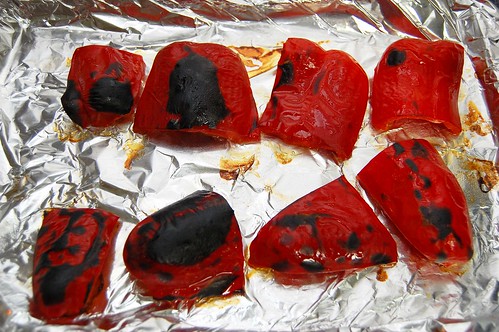Heather and Jane’s birthday party this past Saturday was a blast. There were friends, music, drinks, games and oh-so-much food. The latter has to be expected when one of us is involved. There was mac & cheese, chips, beans, veggies, cakes… enough food to last a lifetime. I offered to help Heather with the food prep because it’s very easy to get in over your head with that sort of thing. Plus, hey, it’s an excuse to cook something.

I made hummus before and I really enjoyed the results, so I decided to try a variation with fire roasted red bell peppers. Now I was going to post that recipe today, but then it occurred to me that there might be some readers out there that don’t know how to fire roast red bell peppers. So instead, we’ll go, step by step, this process.

Option 1 – Open Flame
The easiest way to fire roast red bell peppers is with an open flame, whether it be a grill or a gas stove. Simply place it above so the flames lick the bell pepper and rotate as the skin chars. You really want a lot of charring. It doesn’t need to be completely black, but too little char = peeling difficulty (and sadness). Then place in plastic bag. By putting it an air tight container while it cools, the steaming action will make it easy to remove the skin. Let sit for 30 minutes and peel off the skin with your hands. Then core and seed as usual.

Option 2 – Oven
Some people don’t have a gas stove or grill, but they can always fall back to their oven. Chances are, if you’re fire roasting a bell pepper you’re going to puree, dice, or do some kind of significant cutting to the pepper. Because of this I recommend cutting the bell pepper into eighth; coring and seeding it as you go. This will make it easier to seed as well as ensure that all the pepper is being charred. In addition, ovens often don’t char as evenly (see above) and an under-charred pepper is incredibly frustrating to peel. Set the peppers on a baking sheet on the top rack of your oven and broil, removing pieces as they become charred. No time guidelines here. Just keep a watchful eye!. Then, just like in option 1, remove from the heat and seal in plastic. After 30 minutes, remove and peel off the skin. Enjoy!



















